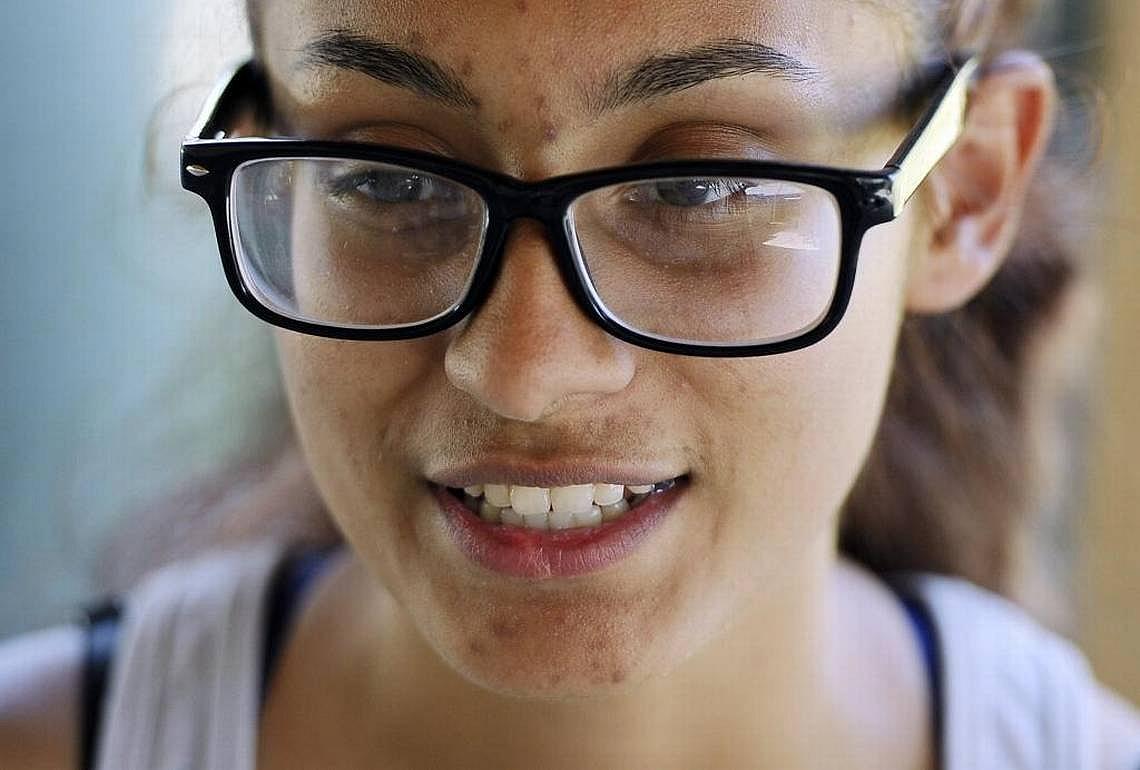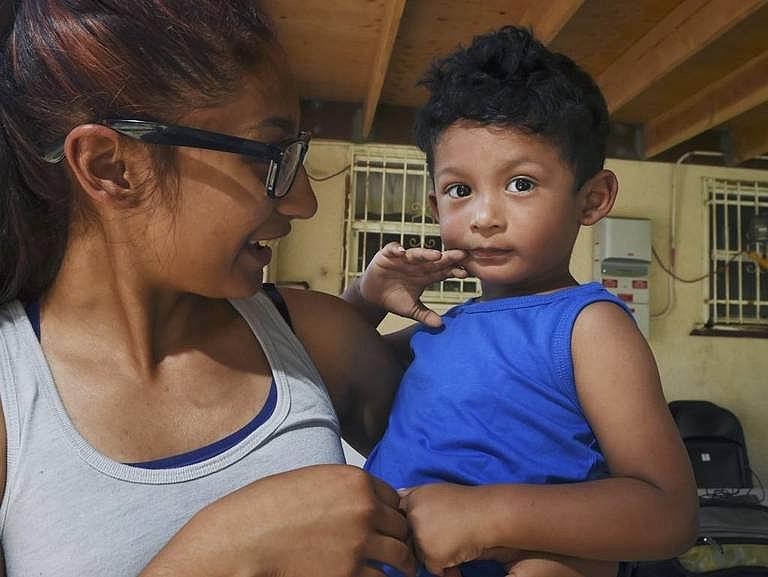Why are birth rates higher for Latina teens than others? It’s complicated, experts say
This story is part of a series about sex education and teen pregnancy, and is produced as a project for the USC Center for Health Journalism’s California Fellowship.
Other stories in the series include:
This teen mom and her newborn rode a city bus to a school for delinquents. Here’s why
At 14, she was told to hide her baby bump and switch schools. Her shaming wasn’t unique
Sex education is now the law, but conservative school leaders aren’t happy about it
After reading teen mom’s story, strangers wanted to help. And they delivered.

Viririana Covarrubias says she was scared to tell her parents that she was pregnant at 15.
When Viririana Covarrubias announced she was pregnant at 15, a family meeting was held. But she was merely a bystander.
Covarrubias and her boyfriend – then both students at Fresno High School – watched as their parents discussed that the two should get married and raise the baby together. Her father and uncles started making plans to convert the garage into a small living space for the soon-to-be family of three.
“They are the typical Mexican family. His parents came to mine and said, ‘We know what our son and your daughter did. They’re now going to be parents. What’s the next step?’ ” said Covarrubias, now 18. “They talked about our options. It was, ‘OK you’re going to keep the baby. Who’s going to work? Who’s going to school? What’s the financial situation?’ That was pretty much it.”
Covarrubias is now a full-time student at Fresno State, picking up shifts at McDonald’s in between classes. She and Martin Reyes are engaged, and their son, Sebastian, is 2.
Reyes didn’t finish high school and currently works at a cellphone company. He says he’s only five credits short of his high school diploma, and plans to finish.
“The baby was coming so I had to start getting money to buy things and try to support the kid,” said Reyes, now 21. “I love my son. It’s the best thing that happened to me. But a lot of things changed. I was only 17.”
I know some parents are scared to talk to their kids about having sex because they think then they're telling them it's ok to have sex. Viririana Covarrubias, teen mom
Reyes’ and Covarrubias’ parents are immigrants from Mexico. In both of their households, sex was a taboo subject.
For Covarrubias, Catholicism plays a major role in her family. She was in the midst of catechism classes when she took a pregnancy test at a Dollar Tree in Fresno.
Viririana Covarrubias’ son, 2-year-old Sebastian, kicks a soccer ball at their Fresno home in May.
“It came up positive, and at first, we were like, ‘It’s not true. It must be because it’s cheap. It can’t be true,’ ” she said. “I had barely finished my sacraments. A lady at church didn’t even congratulate me when she found out – she just said, ‘You need to get married.’ ”
Covarrubias was terrified to break the news to her father. Her mother had told her that if she ever had sex, she needed to ask her for birth control. But when the time came, she didn’t confide in her mother. And her father blamed her mother for Covarrubias’ pregnancy.
“They think if you’re on birth control, you’re having sex and fooling around. I know some parents are scared to talk to their kids about having sex because they think then they’re telling them it’s OK to have sex,” she said. “When I started having sex, I was scared to tell my mom because I felt like I was going to disappoint her. Which, I kind of did because I ended up pregnant.”
Reyes was scared, too. He remembers crying when he finally got up the courage to tell his mother that she was going to be a grandmother.
“I didn’t know how to break it to her. I never had ‘the talk’ with my parents,” he said. “My dad just said, ‘Well, now you’ve got to take care of the child. There’s no going back.’ ”
Racial disparities
Viririana Covarrubias and her son Sebastian, 2, at their Fresno home in May. She was a 16-year-old Fresno High student when she became a mom.
While statewide and nationwide teen birth rates have continued to decrease across all races and ethnicities, disparities persist.
Latinas have the highest teen-pregnancy rate of any group. The birth rate (per 1,000 girls) for white teens in California is nine, compared to a rate of 29 for Hispanic teens, according to the National Campaign to Prevent Teen and Unplanned Pregnancy. The teen birth rate for black teens is also disproportionately high, at 23.
In 2014, the most recent county-level data, nearly 75 percent of the teen births in Fresno County were to Hispanic mothers.
While research shows that poverty, access to health clinics and other socioeconomic factors play a role in teen pregnancy rates, Socorro Santillan, executive director of Fresno Barrios Unidos, has seen family beliefs add barriers to sex education.
“Latina moms have literally said they would rather have their daughter pregnant than on birth control because if the family finds out she’s on birth control, she’s a ho. But if she gets pregnant, ‘Oh, she had sex once and got pregnant,’ ” Santillan said.
Racial disparities also exist among abortion rates. The abortion rate for Hispanic women is double the rate of white women, while black women are five times more likely to have an abortion than a white female, according to a report by the Guttmacher Institute in 2008.
But teenagers only make up about 5 percent of abortions obtained in the U.S. Santillan says that the conversations she’s having with Fresno’s Latino teens rarely involve abortion, especially if their parents are involved.
“It’s not that Latinos encourage teen pregnancy. It’s that the first thought is that they have to have the child,” Santillan said. “Abortion is not even an option for most of our young Latina women.”
Fresno Unified trustee Elizabeth Jonasson Rosas said that a cultural importance of family may be misconstrued as support for teen pregnancies. And she fears politics may play a role in some of those misconceptions.
I understand that some people say it's culture or something about being Latino. But I would argue that it's more about not having access to opportunities. Vincent Guilamo-Ramos, co-director of the Center for Latino Adolescent and Family Health
“The reproductive choices of Latina women have always been scrutinized in general – that we all come here to have anchor babies. There’s that lens, putting it on culture,” she said. “I can see from an outsider’s perspective that maybe in other cultures, a teenager is ostracized for getting pregnant. Here, I wouldn’t say that anybody is out there saying, ‘Good job.’ Nobody wants their teen daughter to get pregnant. But I think you’re seeing more families say, ‘OK, let’s start planning for the future of this baby.’ That may seem to some like rewarding the behavior, but why is this the kid’s fault?”
Jonasson Rosas says the conversations being had at home are just as important as those in the classroom when it comes to sex education.
The California Healthy Youth Act was passed in 2016 and requires that schools teach unbiased and medically accurate sex education, including lessons on abortion. But there is concern about how much support the curriculum is getting in the politically conservative San Joaquin Valley, which has a history of pushback against such lessons.
Meanwhile, the Valley is home to six of the 10 counties with the state’s highest teen birth rates.
“The education system plays a huge role, but we can only do as much as our parents want us to do,” Jonasson Rosas said. “They need to be broaching the subject and talking to their kids, too. If your parent tells you something, it’s way different than hearing it from several other voices. It needs to be all of us. We need all hands on deck.”
Are we reaching them?
Vincent Guilamo-Ramos, co-director of the Center for Latino Adolescent and Family Healthat NYU, is leery of tying culture to teen birth rates. He says that in places like the Valley, which have what he calls “contraceptive deserts,” the primary problem is a lack of outreach to Latino families.
“The question one has to ask is what’s going on here? Why are the teen birth rates improving, but not as dramatically as other groups?” Guilamo-Ramos said. “I understand that some people say it’s culture or something about being Latino. But I would argue that it’s more about not having access to opportunities. There is a lot of data that show when Latinos receive comprehensive sex education that provides them with more effective contraceptive, that they make similar choices to their non-Latino peers.”
I think we need to bring into the conversation not only the existence of sex ed, but what is the quality and approach - and who does it serve? Larissa Mercado-López, Fresno State professor
A survey conducted by Planned Parenthood and the Center for Latino Adolescent and Family Health in 2013 showed that Latino parents are open to more sex education for teens, and see teen pregnancy as a major issue – more so for their communities than others. A third of the more than 1,000 adults polled nationally also said Latino teens have less access to birth control than other Americans.
The work Guilamo-Ramos did with hundreds of families in the Central Valley between 2013 and 2015, implementing the Families Talking Together program, supported the survey’s findings. Families Talking Together is a parent intervention program that aims to prevent and reduce “risky sexual behavior” among Latino youth by getting entire communities invested in sex education.
“Overwhelmingly, there was support for the program. When the parents understand what’s at stake, like most families, when given the opportunity to make decisions in the best interest of their children, they do so,” he said. “The question is: are we reaching them? And doing it in culturally competent ways? And respecting parents’ concerns?”
Support, not punish
Larissa Mercado-López, a women’s studies professor at Fresno State who focuses on Latina issues, warned it’s important not to generalize Latino culture, but said cultural ideas and norms can be factors in teen pregnancy rates and the teaching of sex education.
“It’s partly religious and partly due to the fact that motherhood is an important, revered status within Latino culture. That doesn’t mean that mothers are not oppressed, but it is something that is of value,” she said. “Racism, I would argue, plays an important part in conversations about sex for Latinos. Some studies have shown that Mexican women and youth have more progressive attitudes toward sex, but when they come to the U.S., they are more likely to become conservative. It’s a way of resisting assimilating to a culture associated with sexual laxity. There are pressures to be a model minority or immigrant.”
Mercado-López says the media portray Latinas in two extremes that can make it difficult for young girls to understand a healthy sexuality, and can prevent them from seeking contraceptives or other assistance.
We have to ensure our students receive the information needed to help them make wise choices in their private lives. Claudia Cazares, Fresno Unified trustee
“There’s this idea that Latinas are hypersexual and always available. Then there’s this idea that Latinas should be sexually pure and chaste. It’s very much a conflicting existence, and the messages that they’re receiving are very contradictory, which can have an effect of wanting to turn inward with their questions about sex,” she said. “The dominant narrative about Latinos and sexuality and unplanned parenthood is very oversimplified. I think we need to bring into the conversation not only the existence of sex ed, but what is the quality and approach – and who does it serve?”
Fresno Unified trustee Claudia Cazares, a native of Hanford, had her daughter at 18 as a freshman at Berkeley.
She remembers getting judgmental looks as she walked into class with her baby bump and later pushed a stroller around her prestigious campus. Now, as an elected official, teen motherhood is not something she usually talks openly about.
“I’m not ashamed of anything. But it was very frowned upon, and that made it harder,” Cazares said. “I still think it’s a taboo topic, here especially. I had a lot of support from my husband and fellow classmates, but I can’t imagine what it would be like to not have that support. We need to provide teen moms with the resources in a regular school like anybody else – not punish them.”
Teen moms in the Valley have reported being shamed or pushed out of their schools, or felt that alternative schools were their only option.
Cazares says the disparities among teen birth rates is a complex problem that transcends culture. Regardless of the cause, she says comprehensive sex education can be a solution.
“I didn’t have your typical Latino parents. They were very progressive. It’s not that they didn’t talk about sex, or that they had very strict rules. In my case, it was an individual decision,” she said. “It’s hard to pin it on any one issue, therefore we have to ensure our students receive the information needed to help them make wise choices in their private lives.”
[This story was originally published by The Fresno Bee.]
[Eric Paul Zamora / The Fresno Bee.]

